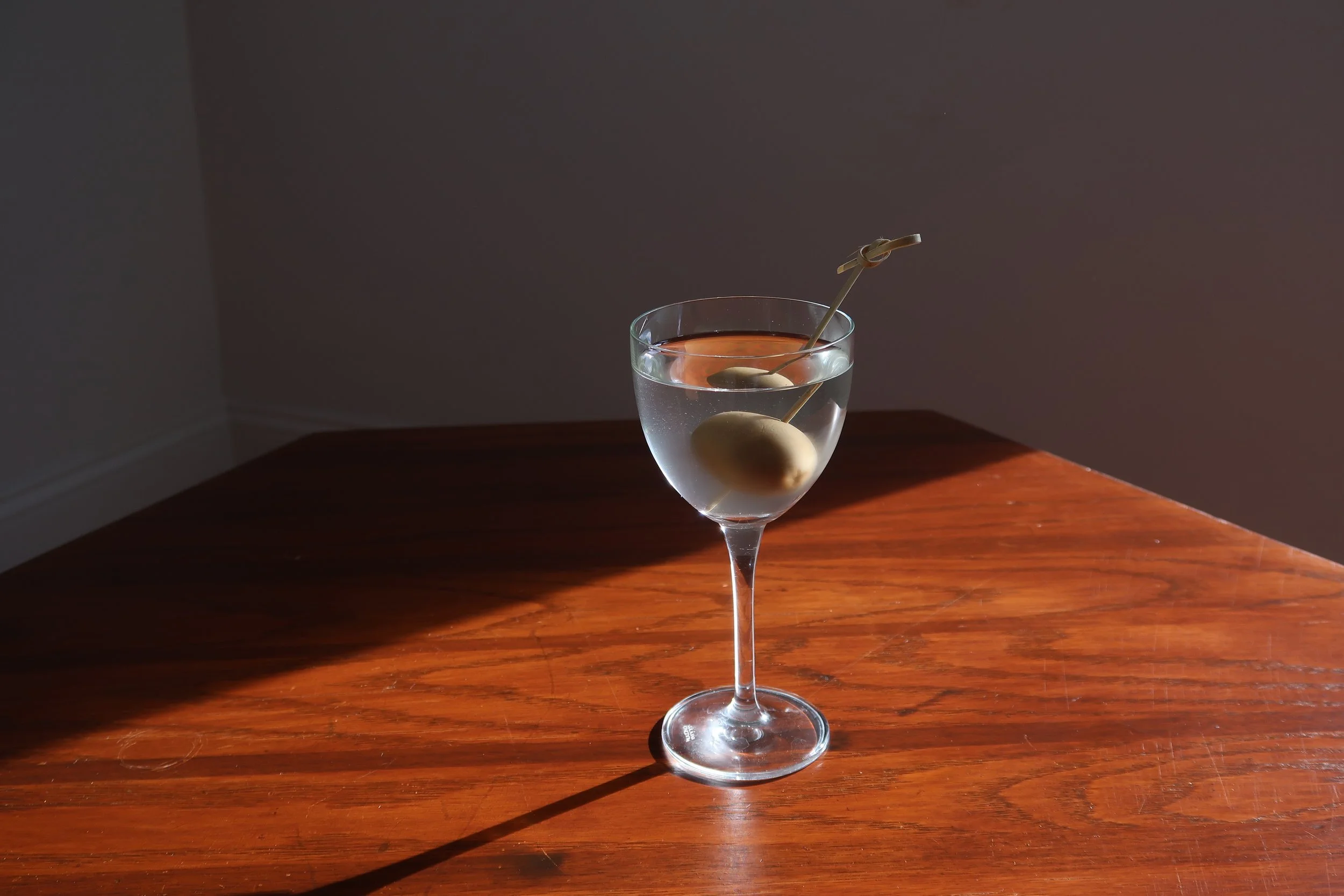Mrs. Shellhammer’s Martini
Inspired by Miracle on 34th Street (1947) and the “double-strength” Martinis prepared so Mrs. Shellhammer will agree to letting Kris Kringle live with her and her husband, who is the toy department chief. I decided to make them “double-pine” with extra juniper-y gin, rosemary-infused vermouth, pine liqueur, and a touch of Chartreuse Élixir Végétal. It tastes like a Christmas tree. Garnished with a quick-pickled cranberry on a pick, which looks stunning in a coupe or Martini glass.
Old Etonian & Fairbank Cocktails
There are two very similar crème de noyaux-laced recipes for Martini-like drinks that emerged in London and Paris during the 1920s: the Old Etonian and the Fairbank Cocktail. The former features a 1:1 ratio of dry gin to blanc quinquina, while the latter tips the scale in the gin direction and calls for dry vermouth instead of quinquina. Both have a slight almondy flavor and reflect the “wetter” Martini style of the period.
Midge Maisel’s Martini
Say what you will about The Marvelous Mrs. Maisel, but the episodes that take place in the Catskills are a feast for the eyes and a window into what these Borscht Belt resorts looked like. Though, as you know, I like my martinis with gin and a ratio of 2:1, I wanted to create a dry martini with a strong herbal quality… and a vodka base. The dill infusion works really well here.
1888 Martinez
The Martinez and other early “Martinis,” were a lot like the first Manhattan recipes. Many such recipes called for a 2:1 ratio of vermouth to gin–which you are welcome to try! I went with 1:1 here. The gin, of course, would have been in the sweetened Old Tom style or Holland gin, aka genever. Lemon is traditional, but I went with an orange twist, wrapped around a cherry for visual interest.
1904 Marguerite
Around 1900, a new style of Martini emerged that featured a drier form of gin (specifically Plymouth) and dry vermouth. One example of this style is a variation called the Marguerite. Its ratio is 1:1 in some recipes and 2:1 (gin:vermouth) in others. Orange bitters and anisette also made their way into these specs. This version is a synthesis of extant recipes, with the pleasant addition of blanc vermouth.
1940 Dry Martini
As the twentieth century progressed, the Martini became increasingly dry. After Prohibition, the ratio had shifted from 2:1 to 3:1, which I think is the optimal Dry Martini spec. For this particular recipe, I encourage you to find a really beautiful gin to showcase over the standard London Dry options. I love the simplicity of a single olive on a pick here.
Tequila Martini
This is an ode to the imaginary point in time, in this month’s period of interest (1900- 1919) when the prevailing Martini ratio was 2:1. Bright, briny fino or Manzanilla sherry works in perfect harmony with the blanco tequila, all of which is enhanced by a little salinity and citrus.
Dinner Jacket
This one takes inspiration from several members of the Martini family tree, including the Vesper, the Marguerite and the Tuxedo No. 2. That last one inspired the name—British import known as the dinner jacket was nicknamed after the Tuxedo Club in Westchester and has been known as such ever since.
Skiing Waiter
This unusual drink is essentially a reverse Martini that swaps dry vermouth for Riesling, and is then poured over a frozen dome (or cube) of citrus-Campari granita. I named it for a well-turned-out waiter who I envision skiing up to perform a tableside service of the drink for your Alpine après-ski.
Fall Martini; or did I reinvent the Appletini?
Back in October 2020, I wanted to create a riff on the classic with unaged apple brandy as the star. So I called on the exceptional gin from Neversink, which uses apple eau de vie as the base and features some beautiful spice notes. This married perfectly with “Jersey Lightning,” an unaged apple brandy from Laird’s. The aromatized wines weren’t hard to choose; I used an extra dry vermouth by Noilly Prat and the Bodegas Hidalgo Manzanilla “La Guita.” The combination of the two gave the drink a bright salinity, which is further bolstered by homemade Martin “brine.” I added a small measure of Salers to bring out the earthy flavors already present in the drink. I called it a fall Martini, but this would be equally appropriate for spring which is, blessedly, not too far off.










